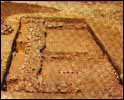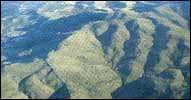| |
Phase
1: 1993-1997
Geoffrey and
Francoise Summers
Kerkenes,
the ancient Pteria of Herodotus, is the largest Iron Age city on
the Anatolian Plateau, its prominent peak dominating the landscape.
Central location provides the key to understanding both its choice
as the western capital of the Median Empire and the brevity of its
magnificence. Few references occur in the ancient sources: Herodotus
locates Pteria east of the Halys River (modern Kizilirmak) and describes
it as the strongest place in that part of Cappadocia. The Byzantine
geographer Stephanos knew it to have been a city of the Medes. Our
research has shown that Median Empire possessed the ostentation
typical of ancient empires and put in place a system of control
that facilitated consolidation and expansion of Iranian power under
the Achaemenids. A new interpretation suggests that Pteria was perhaps
founded by the Medes following the collapse of the Neo-Assyrian
Empire. If so, it would have been the base from which the 5 year
war against the Lydians, culminating in the "Battle of the Eclipse"
on the 28th of May, 585 BC, was conducted. According to Herodotus,
Croesus destroyed it in 547 BC, following his divinely sanctioned
crossing of the Halys, in the mistaken belief that he would destroy
the Persian Empire rather than his own. Croesus enslaved the Pterians
and chased innocent Cappadocians from the surrounding countryside.
Lydian aggression was soon halted by the Achaemenid usurper Cyrus
the Great at the indecisive "Battle of Pteria", fought on the plain
below.


 
In
Phase 1 of the Project mapping from rectified balloon photographs
was completed, geophysical survey showed the potential of remote
sensing and test trenches yielded a wealth and variety of information.
The fully urban nature of the city was established, the sixth century
date confirmed and the final destruction by fire, presumably by
the hand of Croesus, was dramatically revealed. The defences were
studied in detail. A huge complex of planned public structures was
identified on the high southern ridge, including what appears to
be a palatial complex, imperial stables or store houses and a stone
lined pool. Centrally planned, walled, urban blocks, divided by
streets, were seen to occupy the lower area and sophisticated water
management was evident. Geomagnetic survey, supplemented by test
excavations made in collaboration with Musa Özcan, Director of the
Yozgat Museum, revealed architectural forms of Iranian inspiration,
high status objects and an exquisite ivory inlay embellished with
gold, silver and amber. The great temple, beyond the walls, at Karabas,
was recorded and studied. Mapping the surface topography with a
global positioning system and magnetic survey of buried structures
with a magnetometer held out the prospect of creating three dimensional
images that can be combined with both rectified balloon photographs
and architectural reconstructions. Processed satellite imagery and
regional survey was placing the city in its wider physical, cultural
and historical environment.
Methods
and Techniques
A
helium filled blimp with a camera suspended beneath, triggered by
remote control, is used to obtain low level vertical and oblique
photographs. High level photographs were taken from the Cloud 9
Hot Air Balloon in 1993. Once rectified these images can be combined
with measured plans, detailed topographic maps and geophysical maps.
Topographic survey with a Trimble Global Positioning System (GPS)
creates detailed three dimensional models of the terrain surface.
A base station is set over a fixed point and roving receivers, set
to take a reading every two seconds, are carried at a constant height
above the surface. By the end of 1998 350,000 readings had been
taken, covering about one third of the city. Differences between
the earth's magnetic field and the magnetic field in the first meter
below the surface are measured with a GEOSCAN RM 32 fluxgate magnetometer.

Differences
between the two magnetic readings may be caused by past human activity,
such as the construction of walls, which can seen on the processed
images. At Kerkenes a combination of factors yields particularly
striking magnetic maps which contain such detail that even the position
of burnt door posts can sometimes be discerned.
Test trenches were dug to help in the interpretation of magnetic
maps, to discover the function of building types and to solve specific
architectural problems. Chance discovery of high status objects
was an unexpected and welcome bonus.

|